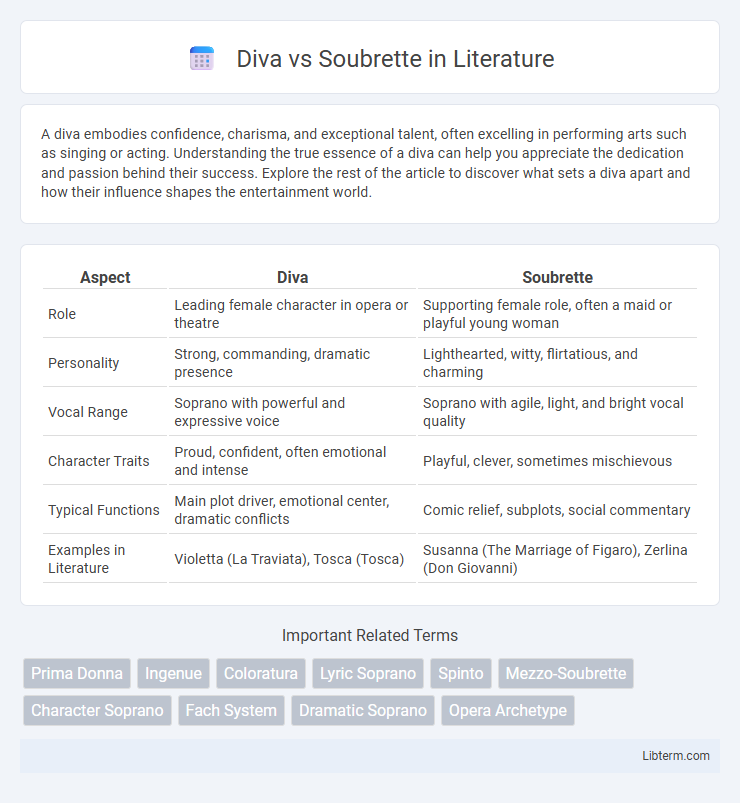A diva embodies confidence, charisma, and exceptional talent, often excelling in performing arts such as singing or acting. Understanding the true essence of a diva can help you appreciate the dedication and passion behind their success. Explore the rest of the article to discover what sets a diva apart and how their influence shapes the entertainment world.
Table of Comparison
| Aspect | Diva | Soubrette |
|---|---|---|
| Role | Leading female character in opera or theatre | Supporting female role, often a maid or playful young woman |
| Personality | Strong, commanding, dramatic presence | Lighthearted, witty, flirtatious, and charming |
| Vocal Range | Soprano with powerful and expressive voice | Soprano with agile, light, and bright vocal quality |
| Character Traits | Proud, confident, often emotional and intense | Playful, clever, sometimes mischievous |
| Typical Functions | Main plot driver, emotional center, dramatic conflicts | Comic relief, subplots, social commentary |
| Examples in Literature | Violetta (La Traviata), Tosca (Tosca) | Susanna (The Marriage of Figaro), Zerlina (Don Giovanni) |
Defining the Diva and the Soubrette
The Diva is characterized by her commanding presence, powerful vocal range, and dramatic flair, often embodying leading roles in operas and musicals. In contrast, the Soubrette represents a light, playful, and coquettish character, typically performing supporting roles that require agility and charm. These distinct archetypes define their contributions to performance art, shaping audience expectations and role specialization in theatrical productions.
Historical Origins of Diva and Soubrette Archetypes
The diva archetype originated in the 18th-century Italian opera, embodying a celebrated female singer known for vocal virtuosity and commanding stage presence, often portraying powerful, dramatic characters. In contrast, the soubrette emerged in French theatre and opera as a lively, witty maidservant, representing youthful charm and comedic relief with light soprano roles. These archetypes reflect distinct social and artistic roles in historical European performance, shaping their enduring cultural significance.
Key Characteristics: Diva vs. Soubrette
A diva embodies powerful vocal technique, commanding stage presence, and dramatic intensity, often performing lead roles in opera or musical theater. A soubrette is characterized by light, agile singing, a playful and coquettish demeanor, and roles that emphasize charm and wit rather than vocal power. While divas captivate with emotional depth and vocal prowess, soubrettes charm audiences with their vivacity and comedic timing.
Iconic Examples in Opera and Theatre
Diva roles in opera, exemplified by characters like Puccini's Tosca and Verdi's Violetta, showcase powerful vocal prowess and dramatic intensity, often commanding the stage with emotional depth. Soubrette roles, such as Susanna in Mozart's "The Marriage of Figaro" and Despina in "Cosi fan tutte," highlight light, agile voices and playful, flirtatious personalities that provide comic relief. These iconic examples illustrate the distinct vocal timbres and character archetypes that define the diva's commanding presence versus the soubrette's charming wit in operatic and theatrical traditions.
Vocal Ranges and Performance Styles
Diva roles typically demand powerful vocal ranges, often spanning from mezzo-soprano to dramatic soprano, emphasizing strong, emotive delivery and technical control. Soubrette roles feature lighter, brighter soprano voices with agile, delicate tones suited for lively, playful characters and quick vocal passages. Performance styles differ as divas embody intense, commanding stage presence with dramatic interpretations, while soubrettes convey charm and wit through spirited, lighthearted acting.
Costuming and Stage Presence
Divas often wear elaborate, luxurious costumes with intricate detailing that emphasize their commanding stage presence and larger-than-life persona. Soubrettes typically don lighter, playful outfits featuring vibrant colors and simpler designs to reflect their youthful charm and energetic movements. The costuming for a diva enhances their authoritative aura, while the soubrette's attire supports agility and approachable appeal on stage.
Personality Traits and Audience Appeal
A Diva typically exhibits a commanding presence, characterized by confidence, assertiveness, and a flair for dramatic expression that captivates audiences seeking powerful performances. In contrast, a Soubrette embodies charm, playfulness, and light-heartedness, appealing to viewers who enjoy wit, vivacity, and approachable charisma. Both personas generate audience engagement through distinct emotional connections: the Diva through awe-inspiring intensity and the Soubrette via relatable charm and spirited energy.
Evolution of Diva and Soubrette Roles
The evolution of Diva and Soubrette roles reflects significant shifts in operatic and theatrical characterizations from the Baroque to the modern era, with Divas embodying powerful, dramatic leads symbolizing emotional intensity and vocal virtuosity. Soubrettes evolved from simple, lighthearted, and flirtatious secondary characters into complex, witty, and agile performers capable of nuanced comedic timing and vocal agility. This progression highlights changing audience expectations and the diversification of performance styles, expanding both roles beyond their original archetypes into dynamic figures vital for contemporary productions.
Modern Interpretations in Popular Culture
Modern interpretations of Diva and Soubrette archetypes in popular culture emphasize contrasting traits: the Diva embodies powerful, commanding presence and vocal prowess, while the Soubrette represents playful, flirtatious charm and agility. Celebrities like Beyonce exemplify the Diva archetype through dynamic performances and assertive artistry, whereas figures like Ariana Grande capture the Soubrette's lighthearted, energetic persona with youthful vibrancy. Contemporary media blends these roles, allowing nuanced representations that challenge traditional gender and performance boundaries.
Choosing the Right Role: Diva or Soubrette?
Choosing the right role between Diva and Soubrette depends on vocal range, character traits, and stage presence. Divas typically require a powerful soprano voice with dramatic intensity, while Soubrettes excel in light, agile soprano roles characterized by charm and wit. Understanding the vocal demands and personality nuances of each role ensures a perfect fit for the singer's strengths and theatrical opportunities.
Diva Infographic

 libterm.com
libterm.com